- The Oral B 3000 vs 5000: Which Electric Toothbrush Is Better? - February 27, 2022
- Kid Tested and Dentist Approved: The Five Best Natural Toothpaste for Kids - February 17, 2022
- Need Orthodontic Treatment, But Not a Fan of Braces? The Five Best Braces Alternatives Available - February 7, 2022
A set of straight pearly whites is always a confidence booster. Sadly, though, not all of us are blessed with perfect, straight teeth. Crooked teeth are commonplace, with nine out of ten people having crooked or misaligned teeth.
While a crooked smile can add to your unique charm, sometimes teeth need alignment, especially if you have severe malocclusion (that is, a poor or crooked bite). The four most common types of malocclusion include:
- An open bite. When teeth do not come together even if the mouth is closed, it is called an open bite.
- An overbite. With an overbite, the upper jaw protrudes too much into the lower jaw.
- An underbite. The opposite happens with an underbite, where the lower teeth extend beyond the upper teeth.
- A crossbite. A crossbite is similar to an underbite, only that it happens with a few teeth instead of the whole jaw.
Orthodontic treatment is particularly important when your crooked teeth start causing problems for you, like pain while chewing or speaking, or wearing your teeth out. Fortunately, braces – as well as braces alternatives – can help you achieve that straight smile of your dreams.
While a perfect set of straight teeth is definitely possible with braces, not everyone is going to be a good candidate for them. For starters, braces can be a bit uncomfortable to use and a challenge to clean, especially when compared to not wearing them.
Simply brushing, flossing, and using mouthwash won’t cut it, either. You may need to have an electric toothbrush and water flosser to get food particles out from every nook and cranny when wearing braces.
Braces can also make a serious dent in your budget, too. Depending on the type, getting braces starts around $3,000 up to $10,000. Some also consider wearing braces to be unattractive. There is some good news in all of this, though: there are several alternatives to wearing braces, which could bring the same results for less discomfort and expense.
My Bottom Line Up Front
Going for choices other than braces does not mean you can just pick a random product on the market. Your gum teeth and overall mouth health is at stake here, so it’s important to choose a product that suits you the best. Some braces alternatives (especially the DIY ones) may bring your teeth more harm than good.
With this, topping my list are clear plastic aligners like Invisalign, as I believe everyone wants their teeth alignment to be as discreet as possible. It won’t hurt to try other alternatives, though.
If you or your orthodontist don’t think clear aligners are best for you, other great options are:
- Ceramic or Clear Braces. Best for when you need the reliability traditional braces can provide, but you want it to be less visible.
- Lingual Braces. Attached at the back of the teeth, these braces stay hidden.
- Hawley Retainers. Removable, repairable, and long-lasting!
- Veneers. For when you want to change the size, shape, and appearance of your teeth
A Brief History of Braces
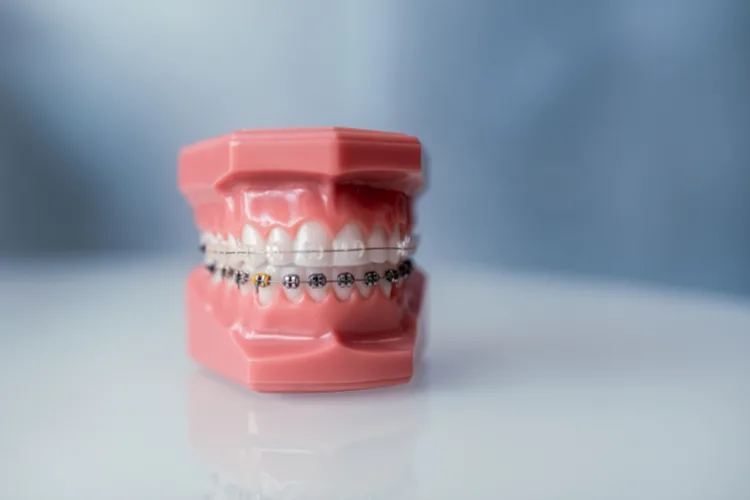
The earliest instances of having brace-like appliances placed on a person’s teeth were seen in Egyptian mummies. They had their teeth tied with a cord-like thread, known as catgut, in what seemed like an effort to close gaps between the teeth. It wasn’t the best way to get straight teeth, though.
Gold wire has also been discovered in a Roman tomb in Egypt, binding the teeth of the skeleton. By the course of history, other metals such as silver, steel, and platinum – alongside nonmetals like ivory, rubber, and wood – were also found, also used just like braces.
The 1700s saw horseshoe-shaped dental devices used to prevent teeth from overcrowding. Called a bandeau, it was helped along by teeth extraction. Imagine how heavy and painful it must’ve been! Plus, it likely took years and years for the teeth to get straightened that way.
In the 1800s, more breakthroughs happened in the world of orthodontic treatment. There was the wire “crib,” and the headgear that pulled braces tight against teeth. Rubber bands were used in orthodontics for the first time. Impacted teeth became easier to remove and find using X-rays.
The 1900s became an experimental era in orthodontics as dentists tried a lot of different materials for braces. Gold was often considered the metal of choice for braces. Not everyone could afford it, though, so wood and ivory were other options. By the 1950s, orthodontists began using silver, but it didn’t become a popular choice until the 1970s.
Speaking of the 1970s, breakthroughs in braces technology surged during that time. Brackets with metal wires attached to the teeth with strong adhesives by now. Before, metal wires were wrapped around each tooth, a considerably painful process.
It was also by then lingual braces (braces placed on the back of the patient’s teeth instead of the front) were developed. Yes, braces still took time to reshape people’s smiles, but they became much more accepted and commonplace as a way to fix one’s smile.
Self-ligating, or self-tightening, braces increased in popularity by the 2000s. The arrival of this kind of brace meant less time needed to adjust the braces, and fewer adjustment sessions meant less discomfort for the wearer. It was also by then that clear aligners that fit over teeth came to be.
Teeth straightening can now be more discreet than lingual braces with the introduction of these aligners like Invisalign and Byte. Then in 2017, a revolutionary dental braces program called Accelodontics was offered, and it promised to straighten teeth by four months instead of the usual years.
As efforts to get a straight smile evolved, so did the methods. Even better, it didn’t always have to be uncomfortable for the person. Fortunately, with today’s orthodontics, this discomfort has now been reduced to a minimum.
The Main Difference Between Braces and Their Alternatives
Braces and their alternatives have the same goal, which is to ease teeth into a position where the correct bite alignment and spacing of the teeth can be achieved. Some of the more notable differences between braces and their alternatives include:
- Their visibility
- The duration of wear
- Their position on your teeth
- The number of adjustments needed
- Their price
- Their overall effectiveness
The differences between braces and other options vary depending on the alternative you choose, so here they are so you can stay guided.
Their Visibility
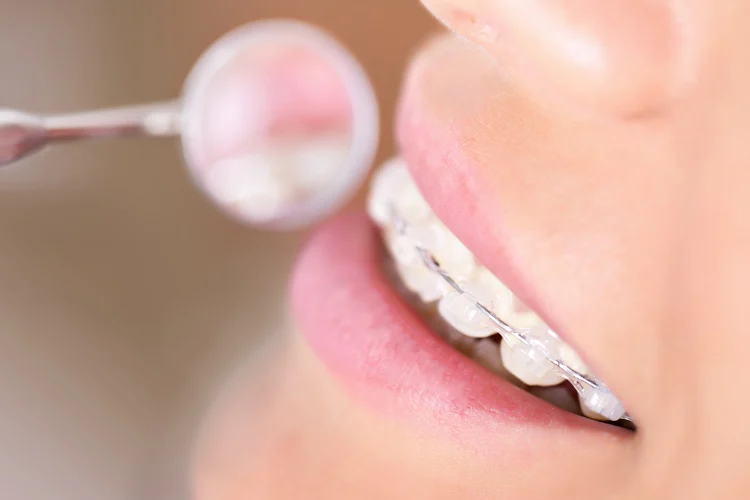
Braces are readily visible, and this visibility is one of the primary reasons why people tend to look for less obvious alternatives. For patients wanting a subtle transformation, veneers are the least obvious, as they’re bonded directly onto the tooth’s surface and look quite natural.
However, they’re the least effective treatment option when it comes to guiding teeth into the right place. Rather, they’re more like a surface cover-up rather than a straightening dental appliance.
Clear aligners are plastic trays that are transparent and push teeth into place. While they’re not completely invisible, they’re not as obvious as the metal wires that are associated with braces.
Ceramic braces can also be clear or tooth-colored so they’re not that visible unless you’re in front of others. Hawley retainers don’t have brackets-only a single wire helping to keep the shape of the arch and therefore less jarring compared to braces.
The Duration of Wear
How long braces and their alternatives stay on largely depends on the severity of the patient’s condition. On average, braces need to stay on for an average of between one to three years.
For example, ceramic braces need to stay on for a year and a half to three years. They need replacement as they get tightened, as they tend to break under the pressure of shifting your teeth.
Hawley retainers can be worn every night indefinitely to maintain your teeth’s position after using metal or ceramic braces or even clear aligners. For clear aligners, they need to be used for at least 12 months, though you can notice results as soon as two weeks after you start wearing them (provided you wear them for around 22 hours a day).
Veneers improve the look of teeth as soon as it is bonded on, and can last up to ten years. However, wearing veneers can’t shift your teeth to the right position. Instead, they can only hide cosmetic irregularities in your teeth.
Their Position On Your Teeth
From my list above, only the lingual brace stays behind your teeth. Clear aligners span both the front and the back of the teeth. All the others sit on the front side of your teeth. However, lingual braces do take quite some time to get used to, due to their position.
The Number of Adjustments and Replacements
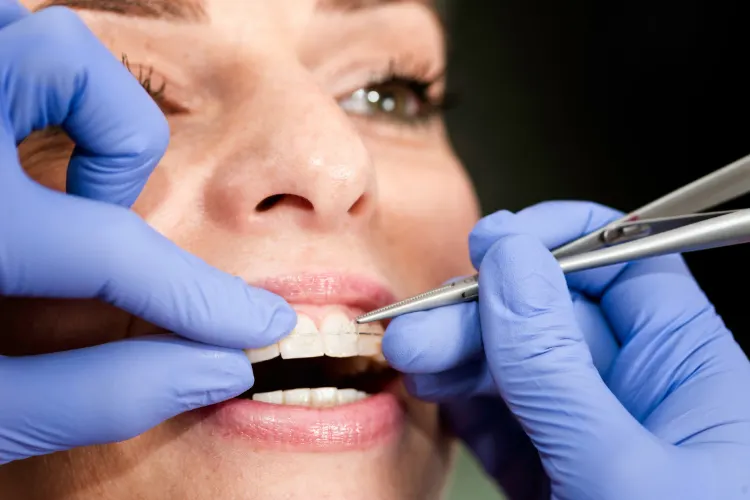
Traditional metal braces require a visit to the orthodontist at least once a month to tighten them. This number is less frequent compared to having clear aligner trays, though.
Instead of being tightened or adjusted, these clear aligners are completely replaced every after two weeks. Having clear aligners also means more visits to the clinic as they need to be regularly checked for every four to six weeks to see if they are working well.
Hawley retainers need to be replaced whenever they become too loose. Follow-up visits when wearing a Hawley retainer are around every three months, which is a lot less often when compared to other options.
Ceramic braces are more fragile than metal ones. This means that it’s reasonable to expect more visits, adjustments, and replacements when you choose this kind of dental brace.
Veneers require no adjustments. As soon as they are bonded to your teeth, they stay in place for five to even years. As long as they don’t crack or chip, veneers are great for the long haul.
Their Price
Ceramic braces are among the most expensive orthodontic treatments, followed by clear aligners, lingual braces, and lastly, veneers. Compared to traditional metal braces, ceramic braces cost around a thousand dollars more, but make up for the price when you want a less obvious choice.
Clear aligners cost more than metal braces, as well, since the trays need replacement every two weeks or so. However, don’t let this hold you back from considering these alternatives, as some of them work faster than traditional braces, or address issues more efficiently than braces can.
Their Overall Effectiveness
The effectiveness of these treatments largely depends on what you want to correct with your smile.
- Between metal and ceramic braces, ceramic braces are somewhat less effective, but can still be a great choice, since they’re less obvious.
- Clear aligners are better than metal braces in addressing minor crookedness and gap issues.
- Lingual braces are quite effective, not to mention less visible – unless someone peers at your mouth very closely.
- Veneers are great for filling in minor gaps.
When Should You Get Orthodontic Treatment?
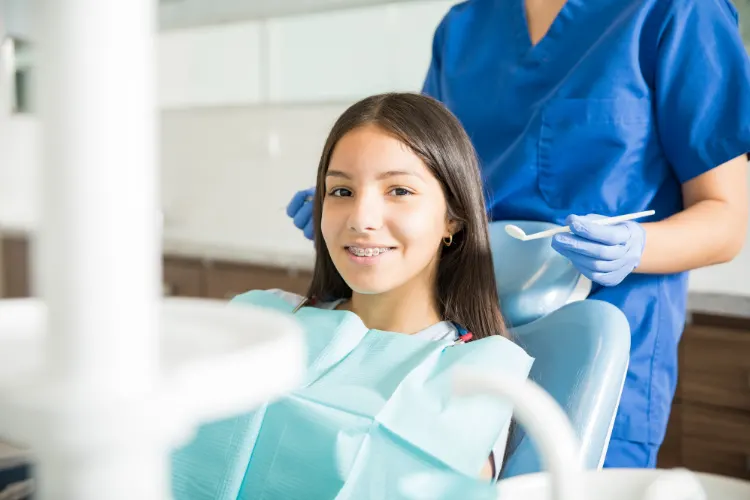
Children, teenagers, and adults can benefit from orthodontic treatment for a variety of oral health benefits. Here are the most common reasons why someone might need to wear braces or any of their alternatives:
- They have crooked or overcrowded teeth. Crooked teeth can lead to chewing problems, affecting your digestion, as food is not properly chewed. As for overcrowded teeth, the more crowded your teeth become, the more problems will arise such as an impacted tooth.
- There are too-wide gaps between teeth. Having a gap in your teeth may add to your uniqueness, but too many of these gaps may cause you to have a lisp. This condition also makes it hard to pronounce certain words. Gaps between teeth often catch food particles and serve as a breeding ground for bacteria, which in turn causes gum problems.
- They suffer from malocclusion. These irregularities in the bite can cause problems in eating and speaking. It also causes self-confidence issues in individuals.
- They make a clicking jaw while chewing or talking. This may be because of misalignments in your teeth or even other conditions, like TMJ (temporomandibular joint disorder), but braces can help address it.
- They mispronounce some words due to the tongue hitting teeth the wrong way. This is also another symptom of malocclusion. Again, the poor alignment of your teeth might not be obvious. However, if you’re having trouble with your speech, your teeth are likely one of the culprits.
- They’re cutting or biting their tongue way too often. If you bite your tongue often, especially at the sides, then you may need braces.
The Benefits of Orthodontic Treatment
Undergoing orthodontic treatment for your malocclusion can help you in several ways. Sure, it might draw extra attention to you and add a few extra steps to your oral hygiene routine at night, but the benefits outweigh the disadvantages.
- Orthodontic treatment helps to improve overall oral health. With straighter teeth, your tongue and jaw can finally function properly. Fewer or no gaps between teeth mean fewer chances for food particles to build up and cause cavities and gum problems.
- It helps you have better digestion. Malocclusion prevents your teeth from properly grinding up your food. You may find that with crooked teeth, it’s hard to enjoy certain foods. Sometimes it is even hard to swallow! Having braces will correct your bite so that you can properly chew your food, especially in the long run.
- It helps prevent bone loss in your jaw. When teeth are misaligned, bacteria can start eating away at the bones. Braces stretch the dental ligaments by flexing the nerves and connective tissue. Eventually, your bones will start to rebuild once they move into the correct position.
- Orthodontic treatment helps you have better speech. Our teeth help a lot in forming sounds that we use in everyday speech. Undergoing orthodontic treatment helps lisps and other pronunciation problems caused by gaps.
- Straightening your teeth builds confidence. Though it may take some time to get used to it at first, getting your teeth straightened gives you the satisfaction that soon you will have the straight smile you wanted.
Why Consider Braces Alternatives Instead of Traditional Braces
People mainly look for alternatives for braces when they don’t want to draw attention to their mouths. Though braces are great in straightening crooked teeth, closing gaps, and addressing other orthodontic problems, some feel that wearing braces interfere with their self-confidence.
Aside from that, there are other reasons why wearing braces may not be an option for a person. For example, they might have an allergy to the metals used in them (particularly nickel). In this case, clear aligners or ceramic braces may work better, but without causing inflammation or irritation.
Other people who are undergoing gum treatments, but also need to align their teeth, usually aren’t offered braces or fixed retainers as a treatment option. This is because they can make certain gum conditions, such as periodontitis, worsen.
Gums are extra sensitive when infected, and braces tend to trap food particles in between teeth when not cleaned properly. For these patients, it’s far better to have a removable dental appliance, such as Invisalign.
Another reason why braces might not be the best option is due to financial constraints. Braces are expensive in general and may require several fittings.
Some people may also find that wearing braces takes too long to see results. Minor problems with crowding, spacing, and bite are also addressed better with the alternatives to braces in lieu of the traditional ones.
The Five Best Alternatives for Braces
Before we get to the good stuff, I want to share how I chose these braces alternatives for my top five list.
My Selection Criteria
For our list, I consulted dental experts and talked with a few people who had treated their malocclusions with these alternatives to give you a comprehensive recommendation. With that in mind, here are my evaluation criteria:
- Their Effectiveness
- Their Visibility
- Their Ovall Price
The products on the following list had to excel in at least one category in order to be considered. Furthermore, they needed to perform adequately in the other two.
It will always be a good idea to speak with your dentist about these options before you make your mind about it. They will be the ones to evaluate your overall oral health and decide if you qualify for any of these braces alternatives.
So here is our top five list of best braces alternatives. Read on and find out what might be a good fit for you!
Clear Aligners

Also known as “invisible” aligners, these are plastic trays fitted over teeth to help correct minor problems with overlapping teeth, malocclusions, gaps, and open bites. Brands like Invisalign and Byte are among the most popular.
Being removable and invisible makes clear aligners a popular choice among those who want to get their teeth fixed. That said, getting clear aligners requires you to change them often to guide your teeth into the proper direction. These aligner trays are customized for each person, and no two aligners are the same.
It’s recommended that you wear your aligners for up to 22 hours a day to gently nudge the teeth to where they should be. You can take it out while eating or brushing, and no one will ever know you’re wearing them — unless you tell them, of course.
There are two kinds of aligners on the market:
- In-office treatment. Your dentist will fit you with these and oversee the treatment
- Mail-order aligners. You can purchase these online and use them without seeing a dentist in person.
The former is generally considered the best option, as your dentist can monitor how much progress you are making. They can also plan ways to correct your smile in the most effective way possible, as opposed to DIY aligner trays.
Clear aligners range in price, from as low as $1,200 to as much as $8,000. The price depends on the brand, the length of treatment, and which type of aligner you choose (worn at night or worn for most of the day).
Pros
- Not visible to the casual observer
- Easy to remove and put back
- More comfortable than traditional braces
Cons
- Generally more expensive than traditional braces
- One can forget to wear it
- Not for severe malocclusion (like a serious overbite or underbite)
Ceramic Braces
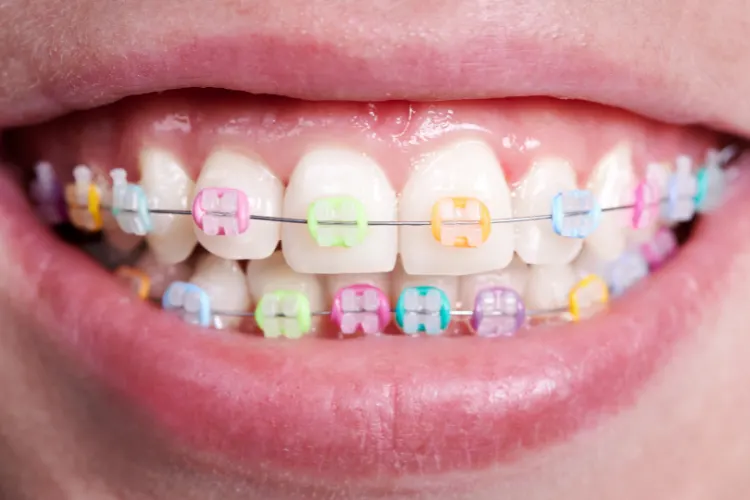
Ceramic braces are a great option if you want the results produced by traditional braces but don’t want the “metal mouth” look. Their brackets are made of clear or tooth-colored ceramic, so the only thing visible is the metal archwire that holds them together
Ceramic braces do cost quite a bit more than metal braces, but they’re less expensive than clear aligners. They also require extra care, too, as the ceramic is more likely to break under pressure. That said, the latest generation of ceramic brackets are much tougher and can withstand an increased amount of pressure.
If you need dental alignment correction, but you feel that traditional metal braces interfere with your smile, then the ceramic braces are meant for you. They don’t show up in pictures, either, so they’re great for people who are always on camera.
Pros
- Works almost the same as metal braces
- Has faster results than Invisalign and other clear plastic aligners
- More comfortable than metal braces with its small, rounded brackets
Cons
- More expensive than metal braces (but less than Invisalign)
- May need to change brackets when broken
- Can get stained by certain foods and drinks
Lingual Braces

Lingual braces arose from the desire to make a dental straightening appliance that stays hidden. They can correct malocclusion issues quite well, too, but they also come with their own set of drawbacks and might not be for everybody.
In general, lingual braces are a good alternative to buccal (traditional braces) if you’re a good candidate for them. If you choose to go with lingual braces, you’ll reap more or less the same benefits as traditional braces, but the price is a bit higher.
Expect to shell out around $5,000 – $13,000 for treatment with lingual braces. However, if you feel more confident straightening your teeth without showing any visible evidence of your treatment, then it can be a sound investment in your smile.
Pros
- Practically invisible to the casual observer
- Corrects the same alignment issues as traditional braces
- Easily customizable for comfort
Cons
- May cause discomfort with your tongue
- Can give you a temporary lisp
- Costs more than traditional braces
Hawley Retainers
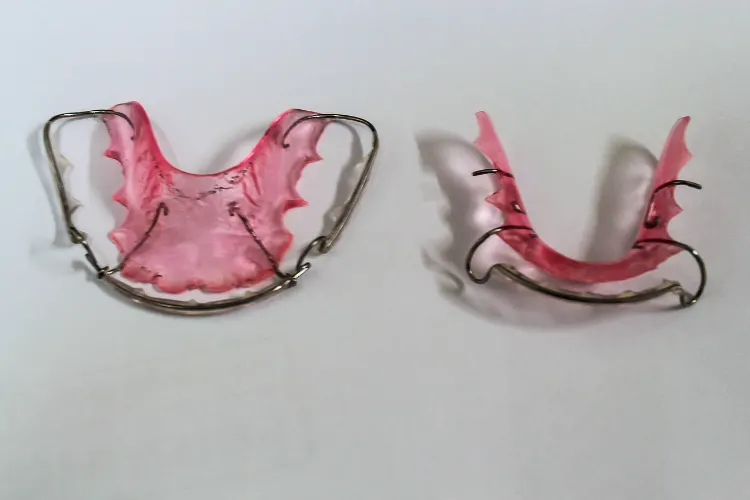
Got minor issues with your teeth? Maybe a crooked tooth or two? You don’t need to get full braces. A retainer can be enough to correct concerns like minor misalignment.
Though usually used to keep teeth in the proper place after using braces, you can take advantage of a retainer to subtly nudge a wayward tooth with it. It will be less expensive than getting a full set of braces, too.
With more serious issues, however, retainers are not going to be your best bet. You have to rely on braces to get the best results. I recommend Hawley retainers over bonded and Essix retainers for minor issues, as the former is cheaper, adjustable, and lasts a long time.
Hawley retainers generally cost around $150-$350 apiece, too. This is much more affordable than bonded retainers, but still a little bit more expensive than clear retainers like Essix and Vivera.
Pros
- Much cheaper than metal braces
- Removable and very easy to clean
- Can last for a long time
- May be easily repaired if damaged
Cons
- Can be easy to forget to wear, since it is removable
- More noticeable compared to Essix retainers
- Can irritate lips and cheeks at first
Dental Veneers
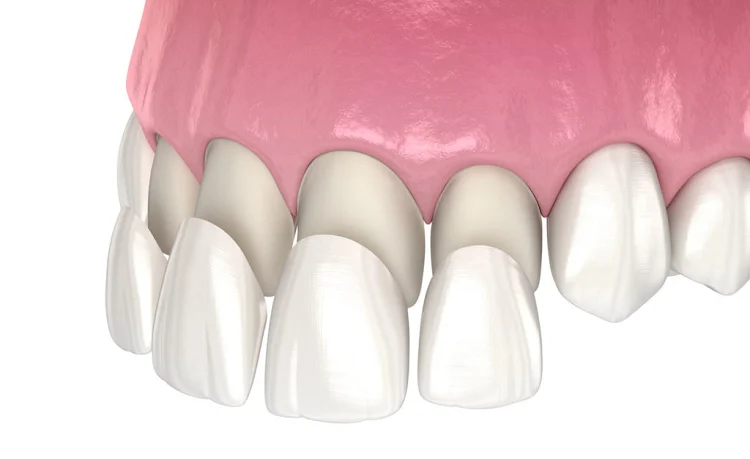
If your problem is a slightly crooked tooth or teeth with small gaps, then veneers can be a great option instead of braces. Not only will this option be cheaper, but the procedure will also take just one or two visits to the dentist.
Veneers are thin porcelain shells bonded to the front of the teeth, giving them a uniform, pleasing appearance. If gaps are your problem, having veneers can eliminate the gap. Keep in mind, though, that veneers are a cosmetic solution.
In other words, they don’t correct extreme problems like an incorrect bite or overly crowded teeth. If done on just a tooth or two, veneers can be relatively cheaper compared to getting braces.
Pros
- Good for fixing extremely minor gaps and cracks in teeth
- Easy to place, compared to braces
- Require no adjustments
Cons
- Irreversible, as some of the enamel needs to be removed to secure the veneer
- Not recommended for extremely decayed teeth
- Not for individuals who have bruxism or teeth grinding issues
My Pro Tips on Picking the Best Braces Alternative For You
While these braces alternatives are considered to be safe in general, there are a few considerations you must weigh before deciding if any of them are right for you. Here’s how you can choose the best option for you:
1. Do Your Research
It pays to know beforehand about the procedures you’re interested in. Comparing prices for clinics may also help you prepare yourself, too, so you can budget for the procedure and save up for it.
2. Consult Your Dentist
No one can evaluate your oral health better than your dentist, and they can determine if you’re a good candidate for a particular procedure. For example, they can tell if your teeth can handle the pressure these alternatives exert. You can also get the best advice on how to achieve the results you want
3. Make Sure You Can Commit
Between cleaning and taking care of them, any of these braces alternatives require a certain level of commitment especially. For instance, clear aligners need to be worn between 22-23 hours to be effective, and lingual braces require special attention when cleaning.
4. Consider the Best Payment Options
Comparing payment options for your treatment is an important step toward achieving that great smile you deserve. Weigh the pros and cons of each payment option (such as through your insurance, financing, or CareCredit) for each, and go with the one that best fits your needs and budget.
Frequently Asked Questions
Answer: Your dentist will be the one to make the final decision, but ceramic braces and lingual braces may be good options to choose from.
Answer: Yes. Consistency is key when wearing products that change teeth alignment, so the more you fail to follow the recommended hours of wearing your aligners, the longer it will take to see results.
Answer: Even if you have the same condition as another person, the procedure you will receive will depend on your oral health and condition. You might be eligible for another treatment instead of the one your friend got. Your dentist will explain it to you.
Answer: Certain foods (such as hard foods, sticky and chewy foods, and foods that need to be bitten off) may make it hard for your braces alternative to work. It’s better to steer away from such foods to ensure the best possible outcome of your treatment.
My Final Thoughts
Getting braces can be great for helping you achieve the smile of your dreams, but these alternatives can also help you reach your dental goals. There’s no need to stick to braces when other options can give you the same results, or even do it faster.
Still, clear aligners – particularly Invisalign, especially under the direct care of a dentist – are my number one choice. Their clear, removable trays work much faster than traditional braces, especially if your condition is not too severe.
Regardless of which braces alternative that you choose, though, as long as you choose one that suits your needs and follow the directions? Well, you’ll be well on your way to straighter, more beautiful teeth in no time!
For more interesting readings check out:

